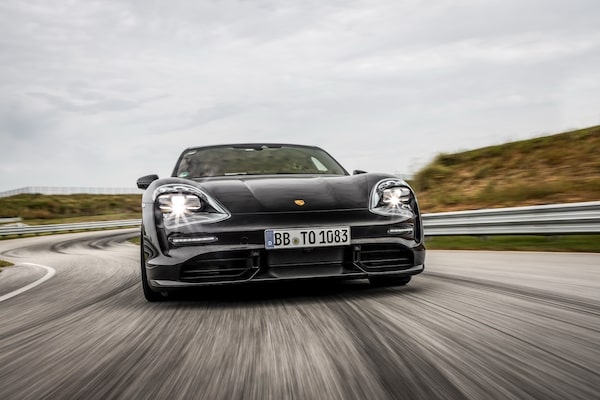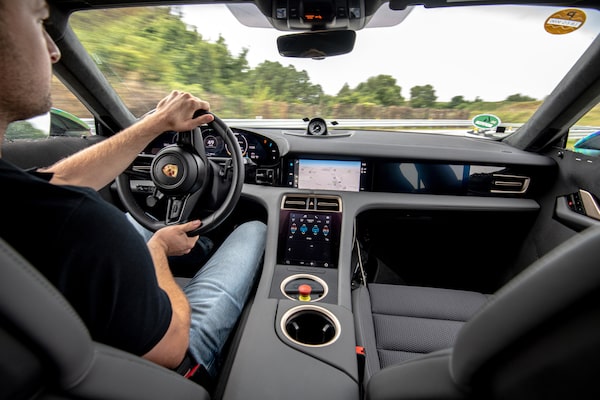
Porsche's first all-electric sports car, the Taycan, is a clear competitor to the Tesla Model S.The Globe and Mail
Let’s get the hyperbole out of the way right from the get-go: The 2020 Porsche Taycan is one of the most important production cars of the 21st century. The reason? This forthcoming all-electric sedan could deliver equal or better performance than the Tesla Model S – and it’s a Porsche.
That’s an important distinction.
Since the introduction of the Model S in 2012, “traditional” automakers have struggled to understand the feverish, unwavering and, at times, seemingly irrational support for Tesla from early adopters, investors and technophiles alike. Without question, Tesla has been a disruptive force in the industry, jump-starting the modern-day battery electric vehicle (BEV) movement. To this point, though, the companyʼs ability to disrupt has hinged on a few critical factors.
Among the most significant: No BEVs compete directly with the three Tesla models – at least, not in a head-to-head, dollar-for-dollar, kilowatt-hour-to-kilowatt-hour type of way. But with the forthcoming Porsche Taycan, billed internally as “the world’s first fully electric sports car,” the Tesla Model S may have a direct competitor – and it may have met its match.
When the first BEV from Porsche hits the market, there will be two models to choose from: the Taycan Turbo and the Taycan Turbo S. (For clarification, neither model features a turbocharged engine. The nomenclature is intended to mirror that used for the Porsche 911 model line.) The difference between the two comes down to the output of the electric motor mounted on the front axle.

The car will come in two models: the Taycan Turbo and Taycan Turbo S.
Both the Turbo and Turbo S feature the same 93.4 kWh battery pack, a network of lithium-ion cells mounted in the floor to ensure a low centre of gravity. Both also have electric motors at the front and rear axles, giving the Porsche all-electric, all-wheel drive. Nothing revolutionary so far, but let’s dig deeper into the technical details.
The Taycan has been engineered for “repeatable performance” – compared with the Tesla Model S P100D, it’s slightly slower from a dead start and has less overall range. However, it should have far more consistent performance.
In its famed “ludicrous mode,” the Tesla can hit 100 kilometres an hour in a revelatory 2.5 seconds, but it would be unlikely to match this time immediately thereafter owing to battery-cooling challenges. The engineers at Porsche have spent the better part of four years tackling these precise challenges.
First, they opted for a permanent magnet synchronous motor (PMSM) for both axles. This design is more expensive than other types of motors, but it’s more compact, more efficient and better able to manage heat. Next, the engineers linked a two-speed transmission to the electric motor at the back, which allows for maximum acceleration in first gear, and a higher top speed and longer range in second gear. (The front motor uses a single-speed transmission.)

Porsche's engineers opted for a permanent magnet synchronous motor (PMSM) for both axles to manage heat.
The Taycan also features 800-volt technology and pulse-controlled inverters for both motors to manage the juice from the battery pack. (The Turbo S employs a larger inverter for the front axle motor, which allows for the increase in power and performance.) Lastly, there’s an intricate thermal-management system that’s designed to keep the battery within the optimal temperature range when driving as well as when the Taycan is plugged in and recharging.
But enough with the words – let’s get to the numbers.
The Taycan Turbo produces 616 horsepower and 627 lb.-ft of torque, all of that available from a standstill. With the overboost function of the electrified powertrain, the horsepower jumps to 670 for brief spells. The claimed zero-to-100-km/h time is 3.2 seconds and top speed rings in at 260 km/h. For the Turbo S, the numbers are more eye-popping: 750 horsepower when in overboost, 774 lb.-ft of torque, the same top speed and the zero-to-100 km/h sprint in 2.8 seconds.
At the end of the technical presentation, attendees had the chance to ride shotgun in the Taycan Turbo S around the Porsche Experience Center, a test track facility in Atlanta. Based on this run, my belief is that Porsche is being conservative with the acceleration figures – my gut, which is still in the back seat of the car somewhere, says a time of 2.5 seconds is closer to the truth.

A ride along in the Turbo S suggested its claimed 0-100 km/h time of 2.8 seconds might be conservative.
As evidence that the objective of repeatable performance has been achieved, the Porsche team put up some even more impressive numbers during development. There’s the new lap record for BEVs around the Nordschleife race course in Germany, which now stands at 7 minutes 42 seconds – a fast time made more newsworthy when you consider there’s been no official attempt made with a Model S. The Taycan also completed 26 consecutive sprints from zero to 200 km/h on an airfield in Germany. The news here: The last run was only 0.8 seconds slower than the first.
Finally, there was an endurance test that took place at the Nardo Technical Center in Italy. Over the course of 24 hours, the Taycan completed 3,425 kilometres at an average speed of 143 km/h. Of note: This run included recharging sessions – and this is another area where Porsche looks to excel. When hooked up to a high-speed charger, the Taycan is expected to vault from a 5-per-cent charge to an 80-per-cent charge in just 22.5 minutes.
In terms of range, the Taycan may not be able to match the Model S. The Turbo offers up to 450 km in range according to testing standards in the European Union or roughly 400 km in U.S. Environmental Protection Agency terms. But the goal for Porsche has not been to match Tesla, measure for measure. The goal has been to engineer a BEV that drives like a Porsche.
So there are only two big question marks left: how the 2020 Porsche Taycan drives and whether prospective customers will pay $173,900 (for the Turbo) and $213,900 (for the Turbo S) for the privilege to own one.
The writer was a guest of the automaker. Content was not subject to approval.
Shopping for a new car? Check out the new Globe Drive Build and Price Tool to see the latest discounts, rebates and rates on new cars, trucks and SUVs. Click here to get your price.
Stay on top of all our Drive stories. We have a Drive newsletter covering car reviews, innovative new cars and the ups and downs of everyday driving. Sign up today.